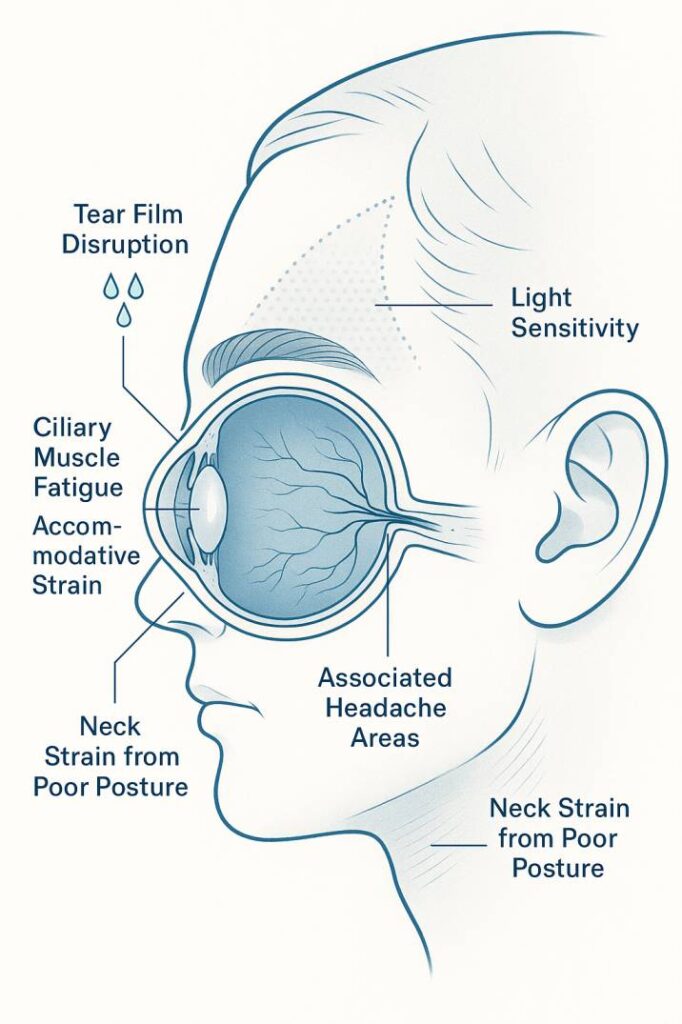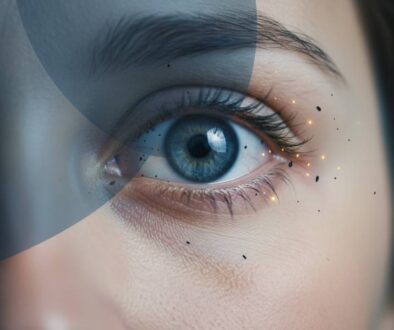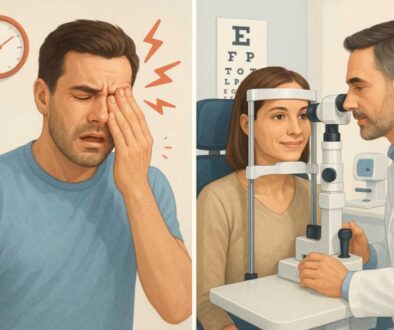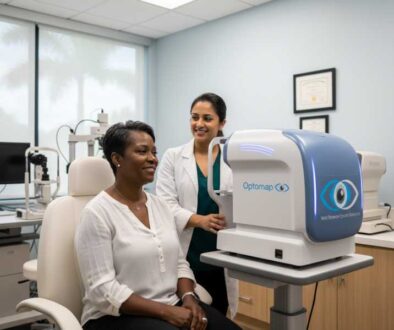Digital Eye Strain : Complete 2025 Guide
Digital eye strain affects 50-66% of digital device users worldwide, with prevalence ranging from 8.2% to 100% depending on the population studied. This comprehensive guide offers evidence-based management strategies to protect your vision and improve your quality of life.
Clinical Definition
Digital eye strain, formally known as computer vision syndrome (CVS), encompasses a constellation of ocular and vision-related symptoms resulting from prolonged use of digital devices. The American Optometric Association characterizes CVS as physical ocular discomfort experienced during or following extended digital interaction.
Unlike transient eye fatigue, computer vision syndrome encompasses a range of comprehensive visual, ocular, and musculoskeletal symptoms that substantially impact daily activities. Contemporary research demonstrates that this condition affects an estimated 50-66% of digital device users globally, with a landmark meta-analysis of 103 studies encompassing 66,577 participants reporting a pooled prevalence of 66%.
COVID-19 Impact: CVS prevalence increased dramatically from 5-65% pre-pandemic to 80-94% during the pandemic era. Among pediatric populations, prevalence rose from 20% to 50-60% during lockdown periods.

Symptom Recognition
Computer vision syndrome manifests through three primary symptom categories:
Ocular Surface Dysfunction Symptoms
These result from diminished blink frequency and compromised tear film distribution:
- Xerophthalmia (dry eyes) – inadequate moisture sensation
- Ocular burning/stinging – pronounced after extended exposure
- Foreign body sensation – persistent gritty feeling
- Compensatory lacrimation – excessive tearing
- Conjunctival hyperemia – redness intensifying with use
Accommodative and Binocular Vision Symptoms
Secondary to ciliary muscle fatigue and vergence dysfunction:
- Visual acuity fluctuations – intermittent blurring during focus transitions
- Accommodative lag – delayed refocusing between distances
- Diplopia – double vision from binocular disruption
- Asthenopia – ocular aching around/behind eyes
- Photophobia – heightened light sensitivity
Extraocular Musculoskeletal Symptoms
From postural adaptations during prolonged screen interaction:
- Cephalgia – tension headaches, temporal and retro-orbital
- Cervical/trapezius myalgia – neck/shoulder pain from forward posture
- Generalized fatigue with concentration difficulties
- Thoracolumbar discomfort – back pain from static positioning
Clinical Note: Progressive myopia represents an emerging concern, particularly in pediatric populations with 4+ daily screen hours.
Underlying Causes
Fundamental Question: Why do digital displays induce greater ocular strain than printed materials?
Display Technology Factors
Pixelated image construction creates content through microscopic light-emitting elements, lacking the crisp boundaries of printed typography. Unlike books with solid black pigmentation, digital text comprises millions of discrete pixels undergoing continuous refresh cycles, necessitating increased ocular effort.
Temporal light modulation generates subtle visual disruption through 60-120 Hz refresh frequencies, creating imperceptible luminance fluctuations, imposing sustained visual system stress.
Short-wavelength light emission from LED displays may contribute to circadian disruption, though current evidence suggests blue light primarily affects sleep-wake cycles rather than causing direct ocular damage.
Visual Demands and Ergonomics
Reduced blink rates occur during concentrated screen use, dropping from 15-20 to 5 blinks per minute, leading to insufficient tear film distribution.
Improper viewing distances/angles force visual systems outside optimal ranges, with most users viewing screens too closely or at incorrect angles.
Poor lighting conditions, including excessive glare, inadequate ambient lighting, or mismatched brightness ratios, compound visual stress.
Management Strategies
The 20-20-20 Rule: Evidence-Based Protocol
Clinical Application:
- Establish systematic reminders every 20 minutes using applications
- Direct attention to objects positioned minimally 20 feet distant
- Maintain focused attention for a complete 20-second duration
- Perform 10-15 deliberate blinks during each break
Evidence Base: 2023 controlled studies revealed significant dry eye symptom improvement and tear film stability enhancement, though overall CVS symptoms showed modest improvement.
Environmental Optimization
Screen Positioning: 20-28 inches (50.8-71.1 cm) from ocular surface, 15-20 degrees below horizontal eye level. Lighting Adjustments: Match screen brightness to ambient lighting, eliminate glare source.s Display Settings: Increase text size, optimize contrast, consider dark mode option.ns
Medical Interventions
Artificial Tears: Preservative-free formulations offer a logical treatment, given the key role of tear film disruption. Studies show a 70% case improvement with proper management.
Comprehensive Eye Examinations: Identify/correct refractive errors contributing to CVS. Specialized Eyewear: Anti-reflective coatings reduce visual effort. Current research indicates blue-blocking filters don’t significantly prevent CVS symptoms.
Comprehensive Prevention Protocol
Pre-Session Optimization:
- Verify 20-28 inch viewing distance
- Confirm 15-20 degree screen positioning below eye level
- Ensure artificial tear accessibility
- Activate break reminder applications
Maintenance During Use:
- Execute conscious blink patterns every 10-15 seconds
- Implement the 20-20-20 rule adherence
- Maintain ergonomic postural alignment
- Sustain adequate hydration
Professional Care Guidelines
Urgent Ophthalmologic Consultation Required:
- Acute visual field defects or sudden visual acuity diminishment
- Severe ocular pain unresponsive to conservative measures
- Persistent cephalgia exceeding 24 hours with visual symptoms
- Binocular diplopia failing to resolve with rest
- Photophobia impairs daily activities
Routine Assessment Recommended:
- Persistent symptoms despite comprehensive management
- Symptoms impacting occupational performance
- Evidence of chronic dry eye requiring specialized intervention
- Need for computer-specific refractive correction
Evidence-Based Resources
Key Research Supporting Clinical Recommendations:
1. Nature Meta-Analysis (2024): 103 studies, 66,577 participants revealed 66% CVS prevalence globally, establishing a comprehensive epidemiological foundation.
Link: PMC Digital Eye Strain Research Database
2. Ophthalmology and Therapy Review (2022): Documented CVS prevalence increase from 5-65% pre-COVID to 80-94% pandemic era, providing crucial treatment context.
Link: Ophthalmology and Therapy Journal
3. Contact Lens Research (2023): Validated 20-20-20 rule effectiveness for dry eye symptoms and tear film stability, supporting evidence-based management protocols.
Link: Contact Lens and Anterior Eye Research
Clinical Implementation Protocol
Immediate Actions:
- Initiate 20-20-20 rule compliance
- Optimize workstation ergonomics (20-28 inch distance, proper positioning)
- Procure preservative-free artificial tears
- Establish proper environmental illumination
Professional Consultation:
Schedule a comprehensive ophthalmologic examination if symptoms persist or impact daily function.
Clinical Summary: CVS affects the majority of screen users; however, through appropriate awareness, environmental optimization, and professional guidance when indicated, patients can effectively manage symptoms while maintaining excellent visual function.
West Broward Eyecare Associates: Specialized CVS Care
Our clinical team delivers comprehensive ocular health services throughout Tamarac, Coral Springs, and West Broward County, providing advanced CVS evaluation and therapeutic management with state-of-the-art diagnostic technology for all age demographics.
Schedule your comprehensive CVS evaluation today for optimal visual comfort in our digital age.
FAQs
-
Digital eye strain is discomfort or vision problems caused by extended screen time. Anyone, including students and professionals, using digital devices for hours daily is at risk




